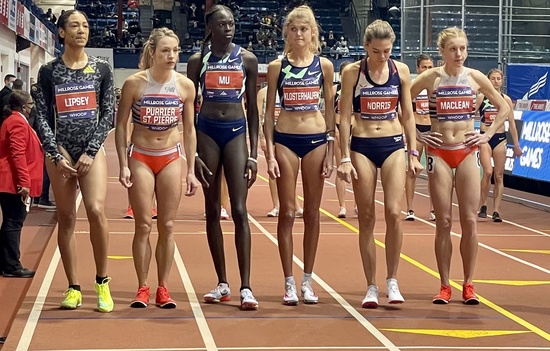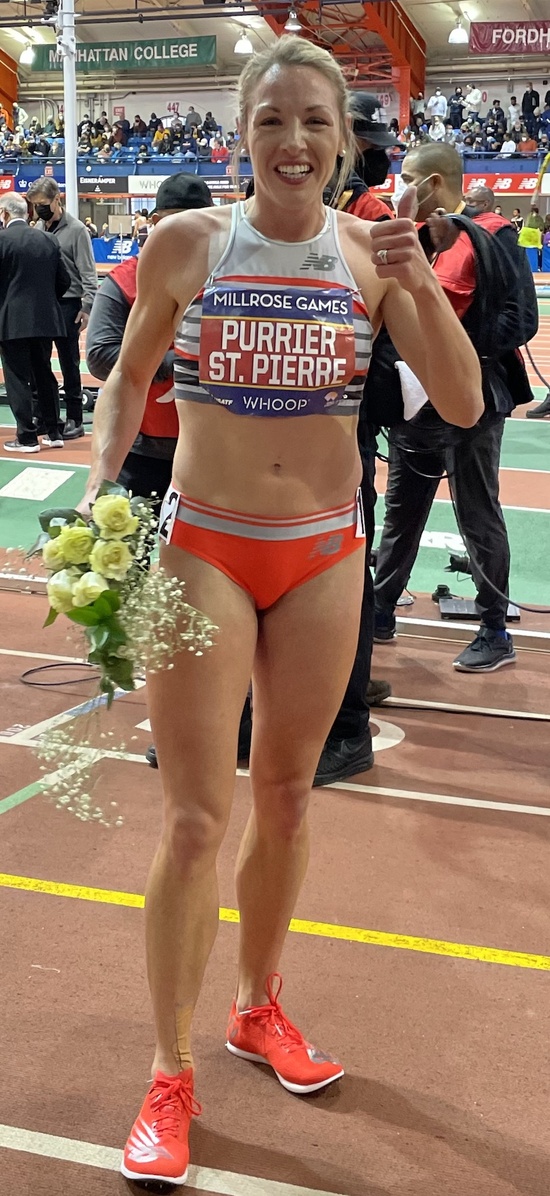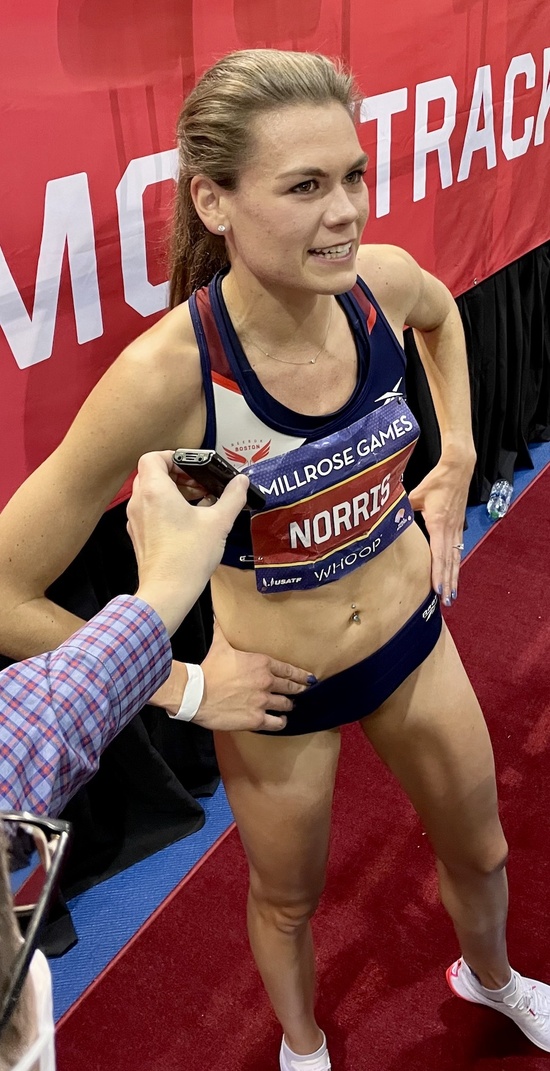The 2022 WHOOP Wanamaker Mile, photo by Jeff Benjamin
RelatedPosts
This article is the twelfth article from Matt Wisner, and this one is on the Women’s Wanamaker Mile. I like the detail that Matt Wisner provides in his stories, he makes word pictures, and that is successful writing. Enjoy this piece from lane one.
Four Stories From the Women’s Wanamaker Mile
By Matt Wisner
Elle Purrier St. Pierre won the race. Josette Norris is no longer a rising star and is just a star. Three Tokyo Olympians flop, including Athing Mu who dropped out of the race with a lap to go. Koko did her thing.
The gun fired, and the pacer, Charlene Lipsey, darted off the line and was quickly 10 meters in front of the field. The other women had already strung out behind Lipsey, one behind the other, and it took another lap for them to shrink the distance between themselves and their guide.
The two most recent Wanamaker Mile champions, Purrier St. Pierre and Klosterhalfen, followed Lipsey the closest. (In the 2020 Wanamaker Mile, Purrier St. Pierre set the American Record in 4:16.85, while Koko finished second. In 2019, Koko won the event in 4:19.98.)
It appeared that the pacing was untrustworthy, but the broadcasters said Lipsey was told to bring the field through in 2:06. It ended up being 2:10 for Purrier St. Pierre and 2:11 and 2:12 for the pack of women following her: Koko, Norris, Jessica Hull, Sage Hurta, Athing Mu, and Shannon Osika.
The race had split into two groups, and two Tokyo Olympians in the event found themselves in the second group: The race was happening up front, and Cory McGee and Heather MacLean were not part of it. Maybe it’s a testament to the strength of the field, but maybe they’re just not ready to compete at their best yet.
Over the past few months, MacLean has had to process the weight that has accompanied her “meteoric rise,” as Scott Cacciola called it in his New York Times story; she made her first Olympic team, didn’t perform quite how she wanted to in Tokyo, came home, resumed hard training, and this race was the first time she’s stepped up to the starting line since. She collected herself in the second half of the race, though, and finished in a solid 4:28.05 for seventh place. (Cory McGee finished 4:33.23, good for tenth place among the 11 women who finished.)
Elle Purrier St. Pierre, 2022 WHOOP MIllrose Women’s Mile victor, photo by Jeff Benjamin
MacLean is healthy and fit but doesn’t dramatically respond to altitude training the same way her training partner, Purrier St. Pierre, does. In the pre-race press conference, Purrier St. Pierre was asked about her 1,000-meter time trial that happened last week because it was rumored to have been very fast despite them being in the middle of a heavy training block. She opted to answer abstractly instead of concretely, saying she’s in good shape without offering specifics. (Purrier St. Pierre’s deflection was more disguised–but way less entertaining–than this deflection of MacLean’s from the Trials last year.)
After she won the race, Purrier St. Pierre offered full disclosure: She ran a 2:34 after coming through 800 in 2:03, and MacLean was only a second behind her. In the Wanamaker mile, MacLean, I guess, was tired–at least more tired than Purrier St. Pierre. She’ll be back. She’s the real deal.
Back to the race. The pacer stopped pacing at the halfway mark, and Purrier St. Pierre gradually quickened the pace. The seven women in the front pack strung out even more, and by 300 meters to go, only three remained. Norris and Koko followed Purrier St. Pierre, but it was clear neither of them were going to beat her. Norris looked down at her feet, as though glaring at them would make them obey her demand to speed up. Koko’s arms flailed even more than normal, elbows wide. Purrier St. Pierre maintained composure.
The bell rang, signifying 200 meters to go, and everybody watched the front three women who had separated from the rest. This is when Mu walked off the track, and nobody really noticed. She slowed to a jog on the home stretch and pulled out wide, exiting to the outside where I was standing with 10 other journalists. Nobody said anything. We all kind of just looked at her, silently, like we were watching an orchestra. It felt almost disrespectful to speak. I would have never been the first to utter something, but after a few moments some guy did, at least delicately: What did it feel like out there?
Mu said, “My PR is only 4:37. I probably would have run faster if I had just finished that last lap.” She’s probably right. It would have only required a 42-second final lap.
It was maybe a brave decision for Mu to run the mile. It’s an event she’s barely run and definitely isn’t as good at as the 800. But maybe it wasn’t brave: It’s been rumored that Mu had COVID a few weeks ago and didn’t want to run an 800 because of the expectation on her to perform extraordinarily. She’s the reigning Olympic gold medalist in a time that might be the true World Record if you scratch dopers and women with dramatically elevated testosterone. That pressure must be crippling–maybe even crippling enough to avoid running your main event, crippling enough to not even finish the off-event you switched to.
Josette Norris, Koko Klausterhalfen, 2022 Millrose Games WHOOP Women’s Mile, photo by Kathy Camara via Peacock TV
Maybe extraordinary circumstances are required for us to forget the most fundamental rule of participating in sport: Never give up.
I don’t want to be harsh toward a 19-year-old, but her behavior to me represents something of the opposite of the Olympic spirit. People online have pointed out that, “There is LITERALLY no other 19-year old American woman alive right now who can do what Athing Mu just did today for 1409 meters,” and maybe they’re right. Coming through 800 meters in 2:10 probably felt at least partially comfortable for a woman who has run 1:55. But every additional meter steepens the task.
When Mu stepped off the track, the 12-woman field became an 11-woman field, and here’s how they finished in the end:
Elle Purrier St. Pierre — 4:19.30 (World Lead)
Josette Norris — 4:20.81 (PR)
Konstanze Klosterhalfen — 4:22.59
Jessica Hull — 4:24.06 (AUS National Record & PR)
Shannon Osika — 4:24.19 (PR)
Sage Hurta — 4:25.45 (PR)
“I don’t always run in the front, but I feel like nobody ever wants to take the pace and somebody’s gotta do it,” Purrier St. Pierre said. “I didn’t want to get mixed up, and I have to have confidence or I won’t do well.” She said some other stuff about how growing up on a dairy farm taught her how to work hard and is truly the backbone of her being, and although we’ve heard it many times before, I’m charmed every time she brings it up. If any other journalists are reading this though, you guys should really ask her something else next time. Shake it up.
Norris finished in second in a new mile PR. She must be the Next Big Thing. Over the summer, she finished third in the Diamond League Final in the 1500 behind two of the best women to ever run the event. She’s consistently at the front of every race she enters. I’m really stoked on her, and I know she’s going to do something huge.
The Wanamaker miles were sponsored by Whoop, and Josette wore hers during the race. Some of my friends who were watching from home were shocked at how low her heart rate was around halfway. They said it was still in the 160s, which is nuts if it’s true. I’m not a huge fan of the Whoop myself (Some part of me is a romantic who is resistant to quantifying and datafying and reducing every element of training to numbers that are each accompanied by strict prescriptions to sleep more or train less or whatever), but I think they came up with a cool way of advertising their product by broadcasting the data live.
“It’s hard to be sharp this early, and I wish I had maybe gone for it a bit more there in the middle,” Norris told me. “I still think I have a lot of room to grow in the 5,000 and would love to go out there [to Worlds in Serbia] and double.” I hope she does! You can do whatever you want!
Third place was Koko. I am a Koko fan boy. When I ran for Duke, before I was even a fan of the sport, a TV in a restaurant where I was eating by circumstance rested on the channel that broadcasts the Millrose Games, and I watched Koko destroy everybody and then give the cutest and most delicate interview I’ve ever seen.
When I talked to her after this year’s race, her demeanor was similar. She praised her competitors and the meet organizers. She’s always just so happy to be there. She said she’ll soon race some 800s to get sharper, and then she’ll be back. Don’t ever sleep on Koko.
Jessica Hull, (former Duck), broke the Australian national record. Shannon Osika PRed, suggesting her decision to join Union Athletics Club was a good one. And Sage Hurta ran a PR in her first indoor race for OAC.
Josette Norris, 2022 Millrose Games, photo by Jeff Benjamin
The race is one story, but within that story are a bunch of other stories, and maybe I’d tell more of them if I didn’t already write so much, but I did already write so much, so this is where it ends. Please exit through the gift shop, and I’ll see you next time!
Author

Dave Hunter is an award-winning journalist who is a U.S. Correspondent for Track & Field News. He also writes a weekly column and serves as Senior Writer for www.RunBlogRun.com, and covers championship track & field competition domestically and in such global capitals as Moscow, Birmingham, Zurich, Brussels, Beijing, Rio de Janeiro, Zagreb, Ostrava, and Doha. Hunter frequently serves as the arena or stadium announcer for championship track & field gatherings, including the Ivy League, the Big East, the Mid-American Conference, the NAIA, the Big Ten, and the Millrose Games. Hunter has undertaken foreign and domestic broadcast assignments. He ran his marathon P.R. 2:31:40 on the Boston Marathon course back in the Paleozoic Era. To find out more about Dave, visit his website: www.trackandfieldhunter.com He can be reached at: dave@trackandfieldhunter.com
View all posts
























